

Schloss Hof
The grounds of Schloss Hof extend across seventy hectares in eastern Lower Austria. The resplendent ensemble consisting of a two-storey palace, the gardens and the estate farm is of outstanding significance in the history of art and culture.
Prince Eugene’s hunting paradise
In 1725, the 62-year-old military commander Prince Eugene of Savoy purchased a one-storey Renaissance citadel with rectangular ground plan and commissioned Johann Lucas von Hildebrandt to remodel it into a prestigious hunting manor.
The citadel was lengthened by two wing constructions to the west. More than eight hundred artisans laboured until Prince Eugene’s death in 1736 to construct among other features a spacious garden with seven terraces. The estate farm built north of the chateau would in future be used for economic provisioning.
Expensive accoutrements
For the exquisite interiors of the palace – the first floor contained Prince Eugene’s residential apartment, the ceremonial apartment (Paradeappartement), thirteen guest chambers, the chapel and the banqueting hall – artists were engaged who had already earned their laurels by contributing to such buildings as the Belvedere palaces. Among them were the interior decorator Claude Le Fort du Plessy and the stucco artists Santino Bussi and Alberto Camesina.
The great inheritance and exhilarating feasts
When Prince Eugene died at the age of seventy-three, his sole living relative, his niece Anna Victoria of Savoy-Soissons, inherited all his possessions and became one of the richest women in Europe. Two years after inheriting, she married the eighteen years younger Prince Joseph Friedrich of Saxony-Hildburghausen, and gave him Schloss Hof and Schloss Niederweiden. Even after the couple’s separation these properties remained in Joseph Friedrich’s ownership and he was expert at exploiting them as venues for luxurious functions and events.
He made use of his last great feast in Schloss Hof in 1754 to sell the property as profitably as possible. For three whole days every conceivable kind of spectacle was dreamed up for the guests of honour – Maria Theresa and Francis I Stephen of Lorraine – in the hope of motivating them to buy. The numerous activities paid off. A year later Maria Theresa bought Schloss Hof and made a gift of it to her spouse.
Owned by the Habsburgs - Maria Theresa’s dowager seat
Shortly after the purchase minor alterations were begun in the palace: Prince Eugene’s private chambers were now used by the imperial couple and newly appointed for this purpose. Until his death in 1765, Emperor Francis Stephen spent several weeks at Schloss Hof, to hunt, or, alongside Maria Theresa and the children, to “relieve the soul of the burden of rule”, as is written in an inscription on the garden-side palace façade.
The palace underwent radical alterations in the 1770s by the imperial court architect Franz Anton Hillebrandt. In order to create extra guest rooms the building was raised a storey. The belle étage rooms were remodelled in Neo-classical style. Maria Theresa, now a widow, had an apartment in the south wing decorated mainly in grey and white. This reconstruction phase gave the palace its modern appearance.



